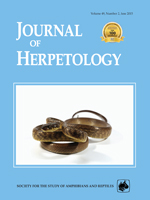Most previous studies of clinging ability in Anolis lizards have focused on how toepads adhere to smooth, flat surfaces; yet lizards in nature use a wide variety of substrates ranging from smooth to rough and narrow to broad. I used an ecologically relevant measure of performance to determine the effects of hind-limb length and substrate diameter on clinging ability for two species of Anolis lizards from the British Virgin Islands. Clinging force was greater on the 12-mm smooth, wooden dowel compared to the 33-mm one for both species. Male Anolis cristatellus had considerably larger hind limbs than female A. cristatellus and both sexes of Anolis stratulus, and consequently performed substantially better on both dowel diameters. Results suggest two important components of clinging ability on cylindrical substrates: first, the ability of lizards to reach around and interlock their limbs with the substrate increases with longer limbs and narrower substrates; and second, the limb strength to maintain a grip on the dowel when limbs wrap fully around and the ability to apply compressive force when limbs wrap only partially around the dowel. These abilities are likely related to muscle size (e.g., cross-sectional area) and may be correlated with limb length. Further studies to understand how multiple morphological traits and different substrates affect clinging performance will contribute to a better understanding of this morphology-performance-habitat use relationship.
How to translate text using browser tools
1 June 2015
Effects of Hind-Limb Length and Perch Diameter on Clinging Performance in Anolis Lizards from the British Virgin Islands
Jason J. Kolbe
ACCESS THE FULL ARTICLE

Journal of Herpetology
Vol. 49 • No. 2
June 2015
Vol. 49 • No. 2
June 2015




